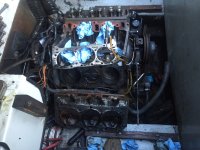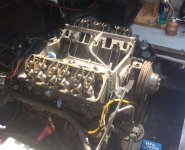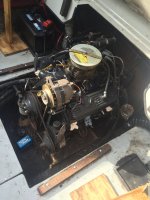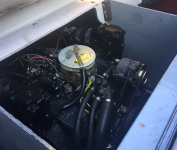Augoose
Lieutenant Junior Grade
- Joined
- Mar 21, 2010
- Messages
- 1,223
I haven't been around the forums in quite awhile as life became busy and the boat has been doing well over the last few years. Unfortunately for me I'm back following a bad overheating event last weekend and near fire on the water.
I did my summerization (fluids, impeller, outdrive, etc) last week and took the boat out this past weekend. Ran across the cove for about 4 mins at 3,000 rpms and after stopping, I noticed a bit of white smoke from the blower and engine compartment. Also a bit of white smoke beneath the swim platform on the surface of the water. Temp gauge read 130 (I know now the gauge failed), oil pressure was around 50 psi (idling). Smoke seemed to stop once the engine hatch was opened. Idled for a few minutes, smoke went away. Ran at about 2,000 rpms for another 30 seconds, smoke came back again. Headed back to ramp at about 3,000 rpms for about 3 mins and heard a popping and crackling sound from the engine and all of a sudden significant loss of power. Turned off the ignition, engine continued to sputter and almost diesel for a few seconds (which it never does).
Opened the engine hatch and white smoke poured out. Cut off the battery switch but the crackling sound continued which sounded like electrical popping. Went through 4 fire extinguishers thinking I had a fire, turns out there wasn't one thankfully. Dumped water all over the engine after extinguishers ran out out of fear of fire. Crackling stopped when we dumped water on the engine. Not a ton of water, a coffee can amount at a time. Temp gauge still read 130 through all of this and I didn't notice what the oil pressure was doing when I stopped the engine. Got towed in by a friendly fisherman.
Fast forward to getting home and inspecting the boat - the exhaust got so hot the outer coating of the elbow melted into some sort of hard plastic and had dripped down. The rubber coupler boot didn't appear to melt. Spark plug wires within a half inch of the pipe seem fine, as does the wiring harness. No melted insulation that I can see. The plastic threaded plugs which allow the manifolds to drain both melted and fell off. No heat damage to upholstery, rubber trim or fiberglass around the engine area. My exhaust manifolds are four years old, visually appear fine, and have only been in fresh water. In the winter I always drain the water from the block/manifolds and then pour in two gallons of marine antifreeze.
I ran a compression check tonight and shockingly I only had two cylinders which were low (one at 125, one at 134). The highest was 183 and the rest were in the 160's and 170's. This was on a cold engine of course. The boat is a '99 with around 400 hours and ran great previously.
Something must be wrong with the raw water flow - either the o-ring didn't seat well when I installed the new impeller (old impeller was intact), maybe the thermostat failed to open, or maybe I have some sore of blockage. I had accidentally left the outdrive at a 45 degree angle (not all the way up not all the way down) over the winter (in South Carolina) and a little water poured out from the prop when I summerized it. The boat is in a pole barn so it shouldn't have been rain water, but possibly some freeze damage occurred? I'll figure out why it wasn't cooling and I'm replacing the temp sending unit and gauge. Here are my questions:
1) What aspect of the engine was likely to suffer during the overheat? Warped head or failed head gasket?
2) If the head was warped or the head gasket failed, I'd assume I wouldn't even get the lowest compression reading of 125 and it would be unlikely to have such high readings on other cylinders?
3) When voltage is removed to a Faria temp gauge, does the needle settle all the way down? Mine is still reading 130.......
4) Could leaving the SX-M lower unit at a 45 degree angle allow sitting water to have frozen in the lower unit and caused damage?
I'm going to inspect and then replace the thermostat, the temp sending unit and temp gauge (it kills me to think I could have prevented this had the gauge been working), disconnect the water line feeding the thermostat housing and connect the muffs to the outdrive and ensure there's no blockage of water flow. If water pushes out to the thermostat housing, I was going to put everything back together and run the boat on muffs to see what happens?
I checked the oil level as it currently sits and its normal in appearance and at the correct level but I'd expect it to be if I wasn't pumping water when the overheating occurred. I assume after a test in the driveway, if the head gasket has failed I'll have milky oil?
Thoughts? Anything else you all suggest doing or checking before attempting to run it in the driveway?
Sorry for being so longwinded, just trying to be as detailed as possible.
Thanks
Augoose
I did my summerization (fluids, impeller, outdrive, etc) last week and took the boat out this past weekend. Ran across the cove for about 4 mins at 3,000 rpms and after stopping, I noticed a bit of white smoke from the blower and engine compartment. Also a bit of white smoke beneath the swim platform on the surface of the water. Temp gauge read 130 (I know now the gauge failed), oil pressure was around 50 psi (idling). Smoke seemed to stop once the engine hatch was opened. Idled for a few minutes, smoke went away. Ran at about 2,000 rpms for another 30 seconds, smoke came back again. Headed back to ramp at about 3,000 rpms for about 3 mins and heard a popping and crackling sound from the engine and all of a sudden significant loss of power. Turned off the ignition, engine continued to sputter and almost diesel for a few seconds (which it never does).
Opened the engine hatch and white smoke poured out. Cut off the battery switch but the crackling sound continued which sounded like electrical popping. Went through 4 fire extinguishers thinking I had a fire, turns out there wasn't one thankfully. Dumped water all over the engine after extinguishers ran out out of fear of fire. Crackling stopped when we dumped water on the engine. Not a ton of water, a coffee can amount at a time. Temp gauge still read 130 through all of this and I didn't notice what the oil pressure was doing when I stopped the engine. Got towed in by a friendly fisherman.
Fast forward to getting home and inspecting the boat - the exhaust got so hot the outer coating of the elbow melted into some sort of hard plastic and had dripped down. The rubber coupler boot didn't appear to melt. Spark plug wires within a half inch of the pipe seem fine, as does the wiring harness. No melted insulation that I can see. The plastic threaded plugs which allow the manifolds to drain both melted and fell off. No heat damage to upholstery, rubber trim or fiberglass around the engine area. My exhaust manifolds are four years old, visually appear fine, and have only been in fresh water. In the winter I always drain the water from the block/manifolds and then pour in two gallons of marine antifreeze.
I ran a compression check tonight and shockingly I only had two cylinders which were low (one at 125, one at 134). The highest was 183 and the rest were in the 160's and 170's. This was on a cold engine of course. The boat is a '99 with around 400 hours and ran great previously.
Something must be wrong with the raw water flow - either the o-ring didn't seat well when I installed the new impeller (old impeller was intact), maybe the thermostat failed to open, or maybe I have some sore of blockage. I had accidentally left the outdrive at a 45 degree angle (not all the way up not all the way down) over the winter (in South Carolina) and a little water poured out from the prop when I summerized it. The boat is in a pole barn so it shouldn't have been rain water, but possibly some freeze damage occurred? I'll figure out why it wasn't cooling and I'm replacing the temp sending unit and gauge. Here are my questions:
1) What aspect of the engine was likely to suffer during the overheat? Warped head or failed head gasket?
2) If the head was warped or the head gasket failed, I'd assume I wouldn't even get the lowest compression reading of 125 and it would be unlikely to have such high readings on other cylinders?
3) When voltage is removed to a Faria temp gauge, does the needle settle all the way down? Mine is still reading 130.......
4) Could leaving the SX-M lower unit at a 45 degree angle allow sitting water to have frozen in the lower unit and caused damage?
I'm going to inspect and then replace the thermostat, the temp sending unit and temp gauge (it kills me to think I could have prevented this had the gauge been working), disconnect the water line feeding the thermostat housing and connect the muffs to the outdrive and ensure there's no blockage of water flow. If water pushes out to the thermostat housing, I was going to put everything back together and run the boat on muffs to see what happens?
I checked the oil level as it currently sits and its normal in appearance and at the correct level but I'd expect it to be if I wasn't pumping water when the overheating occurred. I assume after a test in the driveway, if the head gasket has failed I'll have milky oil?
Thoughts? Anything else you all suggest doing or checking before attempting to run it in the driveway?
Sorry for being so longwinded, just trying to be as detailed as possible.
Thanks
Augoose























